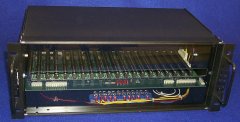|
| |
|
| |
V.23 4-Wire Private Line Analog Synchronous/Asynchronous Modem | 
|
 |
|
FEATURES
|
Looking for a 2-wire asynchronous ony modem? Check out our V.23 asynchronous 2-wire/4-wire model. Click here. |
The modem has a push/push switch for local digital loop on or off. The DIP switch is located on the PC card and is accessible behind the front panel of the standalone modem. The loopback switch is located on the rear of the unit, next to the DB-25 terminal connector.
This modem is compatible with other V.23 modems, and features high
stability transmit and receive frequency circuitry, and a large dynamic
range.
OPTION SWITCH SETTINGS
Switch DOWN UP
1 - N/A
2 - Speed 1200 6s00
3 - RTS/CTS delay 4 ms 8 ms
4 - Carroer Constant RTS Controlled
5 - Clocking Internal External Pin 24 input
6 - Transmit Level See table
7 - Transmit Level See table
8 - Digital Loop Loop On Loop Off
 |
 |
|
|
|
Need it fast? Buy on-line or call toll free 800-432-2638! | |||
| Item Number | Description | Price | Buy Now! |
|---|---|---|---|
| V23-Synch-SA | V.23 Synchronous Modem - Standalone w/ 110VAC wall mount supply | $ 555 | Qty: |
| V23-Synch--12VDC | V.23 Synchronous Modem - Standalone w/9-18 VDC internal power supply | $ 630 | Qty: |
| V23-Synch-24VDC | V.23 Synchronous Modem - Standalone w/18-36 VDC internal power supply | $ 630 | Qty: |
| V23-Synch-48VDC | V.23 Synchronous Modem - Standalone w/36-72 VDC internal power supply | $ 630 | Qty: |
| V23-125VDC | 125 VDC external power supply for use with V23-Sync-SA | $ 125 | Qty: |
| V23-Sync-R | V.23 Modem - Rackmount | $ 445 | Qty: |
| DCBL1 | 20 Slot Rack w/ power supply | $ 1680 | Qty: |
| 9902096 | 19" Rack Bezel 1 unit wide | $ 30 | Qty: |
| 9902095 | 19" Rack Shelf 3 units wide | $ 75 | Qty: |
| Data Comm for
Business Inc. 2949 County Road 1000 E Dewey, Il 61840 |
Voice:
217-897-6600 Toll Free: 800-4-DCB-NET Toll Free: 800-432-2638 |
Email: Contact Page Web: www.dcbnet.com Fax: 217-897-8023 |
|
| All DCB web pages copyright ©1995- Data Comm for
Business, All rights reserved. EtherPath®, EtherSeries®, EtherPoll®, EtherBridge® and EtherModem® are Registered Trademarks of Data Comm for Business, Inc. |
|||